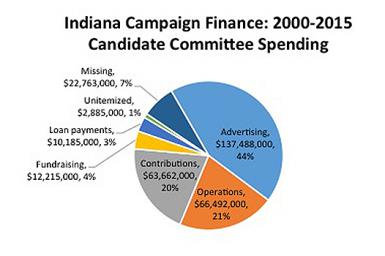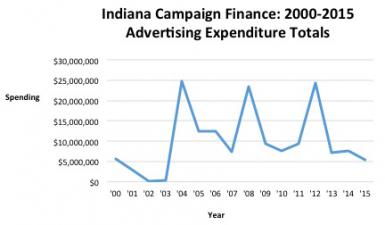Big spenders: What do candidates do with all that money?
By David Pecar, David Wood, Xuan Li and Shakara Williams
When the subject of campaign finance comes up, the focus usually turns to the contribution side of the equation. That is, who’s giving money to politicians, and what do they want in exchange?
Less frequently considered is what politicians do with all that money. A quick look at the state’s campaign expenditure data reveals that candidates and political committees in Indiana have spent more than $800 million on state elections from 2000 through 2015.
And the spending appears to make a difference. It is clear from the data that high expenditures are correlated with victors in state political contests. For example, in the gubernatorial elections covered by the data (full data for the 2016 election won’t be available until next year), the candidate who earned and spent the most was elected.
“Millions of dollars are dumped into campaigns, and generally, the candidate who spends the most to spread his message has the greatest chance of election,” said Ryan E. Mann, former director of special projects for the Indiana Election Division.
Indiana law requires that campaign spending be recorded and submitted electronically to the Division, which is charged with oversight of political fundraising and campaign spending. The law allows four types of expenditures: contributions to other campaigns and local organizations; speaker/venue fees and amenities for campaign fundraising efforts; advertising; and operational expenses such as traveling, headquarter rentals, and postage.
In addition to candidates’ campaign committees, the expenditure data covers organizations such as political parties and political action committees. Those organizations account for six out of every 10 dollars spent in Indiana politics, but more than half of that money goes toward contributions to candidates and party committees.
 From 2000 through 2015, candidates have spent more than $315 million on campaigns, with the largest amount – $137.5 million – going toward advertising. Other major expenses include $66.5 million on operations, $63.7 million on contributions to other committees and $12.2 million on fundraising.
From 2000 through 2015, candidates have spent more than $315 million on campaigns, with the largest amount – $137.5 million – going toward advertising. Other major expenses include $66.5 million on operations, $63.7 million on contributions to other committees and $12.2 million on fundraising.
Given such large amounts, Mann said, it is critical that campaign finances be transparent so citizens can see how the contributions are being spent.
“With money playing such a large role, it helps when spending is reported so that people can see whether their donations are used appropriately,” he said.
Lack of enforcement and missing data
As it turns out, oversight over campaign fundraising and spending is largely left up to the public, the media or candidates themselves. Although the election division recognizes the importance of oversight, it doesn’t have enough workers to parse the troves of data that it receives in minute detail. As a result, there are no routine audits that could identify and report any problems in the data.
“We can only address discrepancies when they are brought to our attention,” said Bryce Bennett Jr., chair of the Indiana Election Commission. “This generally results from a complaint that is filed by an aggrieved party.”
Such complaints typically come from political candidates, as was the case at the local level in northern Indiana last year when an opposing candidate accused Gary Mayor Karen Freeman-Wilson of illegal expenditures.
For those who are motivated, it is possible to keep tabs on all the campaign spending by running searches on the Indiana Election Division’s campaign finance website or by downloading and analyzing the data. But missing information in the state’s data makes it difficult to get a full picture of what is happening with campaign money. And the lack of enforcement makes it easy for committees and candidates to skirt disclosure requirements without consequence.
For instance, many campaigns use credit cards for expenses and then simply note the credit card payment as the purpose of the expenditures. Such payments amount to more than $260,000 – a small chunk of the data, but one that is effectively in the dark for the public.
In fact, committees are required to disclose the type of spending for each itemized expense entry, but about nine percent of the spending data since that requirement took effect – more than $74 million worth of expenditures – are missing the expenditure codes. Much of the missing data is from just two years, 2000 and 2009, but in 2015, about four percent of the spending was not coded, totaling $1.3 million.
 Campaign finance reports that are missing such data are considered defective by the state and may be subject to a civil penalty of $10 a day, up to a maximum of $100, plus investigative costs. But actual enforcement is infrequent at best.
Campaign finance reports that are missing such data are considered defective by the state and may be subject to a civil penalty of $10 a day, up to a maximum of $100, plus investigative costs. But actual enforcement is infrequent at best.
“We don’t sit down and audit every single report, so instead these issues are brought to us by complaint,” said the Election Division’s Michelle Thompson. Asked how often fines are administered and how much candidates have paid in penalties, she was unable to provide figures. According to the Center for Public Integrity, however, penalties are rarely collected. The Center studied campaign finance systems in all 50 states and ranked Indiana’s 47th because of loose restrictions and poor enforcement.
Millions in advertising dollars
In spite of the issues with the data, it is possible to glean some general conclusions about campaign spending in Indiana. The most visible way candidates spend money is on advertising. From 2000 through 2015, state candidates spent about $161 million on advertising, making it the largest category of spending by far. Candidates advertise in myriad ways, including websites, billboards, yard signs, newspaper ads, television commercials, radio spots, clothing and merchandise, social media and even a demolition derby car. As you’d expect, advertising expenditures spike during election years, with state office candidates spending a total of about $25 million in each of the last three statewide campaigns.
 While voters often complain about the ubiquity of political advertising, there is little question that advertising counts. Who spends the most? In a word, winners. Correlation doesn’t always equal causation, but the data suggest a strong link between advertising and winning campaigns. For instance, in each of the three previous gubernatorial races, the candidate who spent the most on political advertising went on to win the election. (Results from this year’s election will not be available until candidates’ 2016 annual reports are filed in January.)
While voters often complain about the ubiquity of political advertising, there is little question that advertising counts. Who spends the most? In a word, winners. Correlation doesn’t always equal causation, but the data suggest a strong link between advertising and winning campaigns. For instance, in each of the three previous gubernatorial races, the candidate who spent the most on political advertising went on to win the election. (Results from this year’s election will not be available until candidates’ 2016 annual reports are filed in January.)
In the 2004 race for governor, Republican Mitch Daniels outspent and subsequently beat Democrat Joe Kernan $11.8 million to $9 million. Daniels repeated the process during his reelection race in 2008 against Democrat Jill Long-Thompson, outspending her $12.5 million to $2.5 million. And in 2012, Mike Pence continued the trend by outspending and beating opponent John Gregg $8.7 million to $3.5 million.
Campaign consulting costs
Another key area for campaign spending – though much smaller in scope – is political consulting. The use of consultants is common in statewide races, providing candidates with consistent marketing and communications, opposition research, and directed fundraising efforts.
“Political consultants provide highly-specialized services to campaigns,” said Mike Disharoon, director of operations at the consulting firm Trilogy Interactive, which was paid nearly $200,000 for work on Democrat John Gregg’s unsuccessful 2012 gubernatorial campaign. “A consultant can build up experience and relationships with vendors over time, in a way that campaign staff simply don’t have the longevity to get together.”
Andrew Downs, an associate professor of political science at Indiana University-Purdue University at Fort Wayne, said it is possible to find a consultant to help with virtually any part of a campaign. Candidates often hire a variety of experts to analyze historical voting patterns, poll likely voters, design targeted communication strategies, produce media elements to fill out those strategies, prepare candidates for debates and public appearances, attract wealthy donors, and much more. This specialized approach means that hiring consultants can be more economical than assembling a permanent staff.
While the state doesn’t require campaigns to identify spending on consulting, committees must state the purpose of expenditures. From 2011 to 2015, mentions of consulting costs in the database’s purpose field account for a total of about $4.6 million. That figure is likely somewhat low, however, since reporting of spending purposes is spotty. About a fourth of the data in 2015, for instance, contains no information in the purpose field.
Still, it is possible to identify 200 consulting companies from 16 different states. Top companies include Mark It Red LLC of Zionsville, Kyle Walker Consulting of Indianapolis, The Polling Company of Washington, D.C., Sextons Creek LLC of Indianapolis, Trilogy Interactive of Mountain View, Calif., and Hathaway Strategies of Indianapolis.
Political consulting has been around a long time. Since 1969, the industry has had its own association, the American Association of Political Consultants, and the organization gives out annual awards – the Pollies. Trilogy Interactive, for one, has won several Pollies in recent years.
Trilogy’s Disharoon said consultants’ roles have expanded with the increasing need to target specific demographics, manage public perceptions and navigate advocacy groups.
“The biggest change has been the growing role of digital marketing in political campaigns,” he said. “This involves digital marketing consultants like us, of course, as we do things like manage email programs and social media profiles that simply didn’t exist 15 years ago. It also bleeds into other political consulting services such as video ads and direct mail.”
More:
- Learn more about this reporting project
- Primer on the big numbers in Indiana state politics
- Defective data: Inconsistencies in reporting and regulating campaign finance in Indiana
- Corporate cash helps fill Indiana politicians’ coffers
- No limits: Political action committees pump millions into state elections

